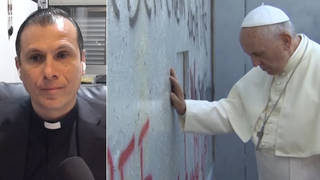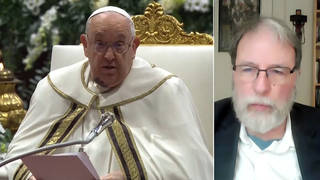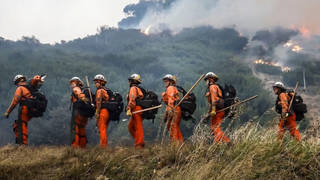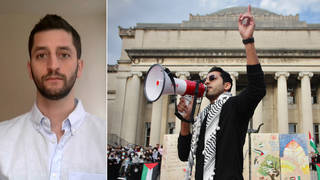
We look at the corporate profiteering off people who lost their homes and loved ones to recent fires in California, where wildfires continue to rage amid record temperatures. A major investigation by KQED and NPR’s California Newsroom found a special trust set up to distribute $13.5 billion to survivors of wildfires caused by PG&E — the state’s largest utility company — instead spent lavishly on its own administration while distributing almost nothing to the 70,000 fire victims, many of whom still live in trailers. Those who profited while the fire victims waited for help included Wall Street bankers and prestigious law firms. The investigation has prompted a bipartisan call from state lawmakers for the state attorney general to investigate. “A lot of fire survivors are looking at this situation and wondering: Why is this taking so long?” says Lily Jamali, a co-host for KQED’s The California Report and the reporter behind the exposé. “They’re getting really impatient, and they’re very unhappy with the way this process has been run so far.”
Transcript
AMY GOODMAN: This is Democracy Now! I’m Amy Goodman.
As wildfires rage in California, we look now at the corporate profiteering off of those who lost their homes and loved ones to recent fires. A major investigation by the NPR and PBS station KQED in San Francisco found a special trust set up to distribute $13.5 billion to survivors of wildfires caused by PG&E, California’s largest utility company, instead spent lavishly on its own administration, while distributing almost nothing to the 70,000 fire victims. This includes victims of the 2018 Camp Fire in Paradise, many of whom continue to live in trailers. Those who profited while the fire victims waited for help include Wall Street bankers and prestigious law firms. KQED revealed the Fire Victim Trust is led by retired California Appeals Court Justice John Trotter, who billed $1,500 an hour for his work. The findings have prompted a bipartisan call from state lawmakers for the California attorney general to investigate.
For more, we go to Berkeley, California, to speak with the reporter behind this exposé. Lily Jamali is co-host and a correspondent for KQED’s The California Report. Her latest piece is headlined “A Year After PG&E Left Bankruptcy, Spending by Fire Victim Trust Remains a Mystery.”
Welcome to Democracy Now!, Lily. Congratulations —
LILY JAMALI: It’s so good to be on with you, Amy. Thank you.
AMY GOODMAN: And congratulations on this excellent report. Why don’t you lay it out for us? And for a global audience, explain what PG&E is and its role in these fires, and then go on from there.
LILY JAMALI: Sure. Well, this was a joint investigation that was done with us at KQED and with NPR’s California newsroom. And as you mentioned, PG&E is the largest utility in California. It’s actually the largest utility in the country, as well. And in the last half-decade, this utility has been responsible for causing several catastrophic wildfires. The worst took place in 2017 and 2018, but there are people who were affected by these fires all the way back to 2015. And so, after that last fire which you mentioned, the Camp Fire, which destroyed much of the town of Paradise — people might remember that. It killed at least 85 people, destroyed thousands of homes and left tens of thousands of people homeless. After that fire, PG&E chose to go into Chapter 11 bankruptcy protection. And by doing that, they took all of these claims that people had against them, having lost their homes, having lost their businesses, and, in the worst cases, having lost their loved ones, they all got thrown into the bankruptcy process. And so, that’s sort of where the story that we have been reporting really begins.
About a year into the bankruptcy, PG&E struck a deal with fire survivors, 70,000 of them, through their lawyers, that basically called for them to have a special trust set up to distribute what was then marketed to them as being worth $13.5 billion, half of it in cash and half of it in PG&E stock, which, as you might imagine, is very unsettling for a lot of fire survivors, this idea of being asked to accept stock in the company that harmed them. But as we sit here today, through this trust, fire survivors do own 500 million shares of PG&E. And so, that is part of the reason why it has taken quite a bit of time to get this money into the hands of victims.
But our investigation also looked at the claims processing expenses that this trust, led by former appeals court Justice John Trotter — how much they have taken in in overhead. He is charging $150,000 a month. The top claims administrator charges $1,250 an hour. There’s a whole coterie of bankruptcy attorneys and financial advisers, many of whom are making well over $1,000 an hour. And so, you really have this giant entity that is taking in a lot of money. We showed that they took in $50 million in overhead in their first year of operations, while distributing just $7 million in the calendar year 2020 to these fire survivors.
The pace of those payments to fire survivors has picked up. At this point, they have distributed north of about $400 million. But their expenses have also risen to the range of about $80 to $90 million. And I think a lot of fire survivors are looking at the situation and wondering, “Why is this taking so long? If you are spending this kind of money on overhead, what are they getting in return?” And they’re getting really impatient, and they’re very unhappy with the way this process has been run so far.
AMY GOODMAN: What is the status of the bipartisan calls for the California attorney general to investigate this?
LILY JAMALI: Yeah. So, after our investigation — as you say, this was a bipartisan group of about a dozen state lawmakers here in California. Most of them — in fact, I think all of them — represent communities who have been affected by these catastrophic fires. And they went to Attorney General Rob Bonta and said, you know, “Look at this. Please take a look and review the claims processing, the way it works, and the amount of money that’s being spent on overhead. Please vet this.” We have reached out to the Attorney General’s Office a number of times to see if they are planning to pick that up and run with it. At this point, we don’t know. They’ve told us that they can’t comment even on a pending investigation or can’t comment on even if they’re thinking about opening up an investigation. But certainly, you know, our work, thankfully, was able to get this in front of some influential lawmakers, including members of Congress who expressed outrage after we released our findings. And, you know, we’ll see. We’ll see what comes next.
AMY GOODMAN: What about Paradise and the areas right around it being threatened again? I mean, we’re talking in the midst of more horrendous fires through California, Oregon, Washington state. And what kind of preparations are being made? You’ve also got PG&E last August instituting rolling blackouts that put 800,000 Californians into the dark. How can Governor Newsom — how he’s dealing with what’s happening right now?
LILY JAMALI: Yeah, I mean, I was so struck hearing your conversation earlier with Michael Mann, because you guys were talking about a climate emergency being here, and that is exactly what it feels like to live in California right now. The rolling blackouts of last year was actually instituted by the Independent System Operator here in California because they ran out of power. They didn’t have enough reserve in their system, so they ended up instituting these rolling blackouts over two days in August. But there is another kind of blackout that is called by the utilities, including PG&E, because their lines have caused so many fires. That’s one way that they now try to prevent their aging and poorly maintained equipment from sparking future fires. Generally, those kinds of — those outages come a little bit later in the fire season, when we see — for example, next month, we’ll see more wind events, and that’s when the situation becomes really dire.
But there’s no doubt about it: We are in a climate emergency here. And one of the fires that we have been tracking, among several, is the Dixie Fire, which just broke out this week, very close to the burn scar of the Camp Fire. In fact, it started very close to the ignition point of the Camp Fire. And I’ve been getting texts and emails —
AMY GOODMAN: We have 10 seconds.
LILY JAMALI: — from people in Paradise who are very concerned. And they’re seeing this smoke in the air, and they’re worried. They’re worried about what to do and how to make sure they’re safe.
AMY GOODMAN: Well, Lily Jamali, we want to thank you so much for your superb reporting, co-host and correspondent for KQED’s The California Report. We’ll link to her investigation, “A Year After PG&E Left Bankruptcy, Spending by Fire Victim Trust Remains a Mystery.”
And that does it for our show. I’m Amy Goodman. Stay safe.













Media Options